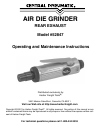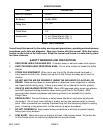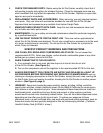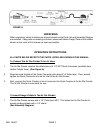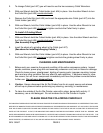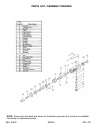9. CHECK FOR DAMAGED PARTS. Before using the Air Die Grinder, carefully check that it
will operate properly and perform its intended function. Check for damaged parts and any
other conditions that may affect the operation of the Air Die Grinder. Replace or repair dam-
aged or worn parts immediately.
10. REPLACEMENT PARTS AND ACCESSORIES. When servicing, use only identical replace-
ment parts. Only use tools and accessories intended for use with this Air Die Grinder.
Approved tools and accessories are available from Harbor Freight Tools.
11. MAINTAIN THESE PRODUCTS WITH CARE. Keep this tool and accessories clean and
dry for better and safer performance.
12. MAINTENANCE: For your safety, service and maintenance should be performed regularly
by a qualified technician.
13. USE THE RIGHT PRODUCTS FOR THE RIGHT JOB. There are certain applications for
which this Air Die Grinder was designed. Do not use a small tool or accessory to do the work
of a larger industrial tool or accessory. Do not use this Air Die Grinder for a purpose for
which it was not intended.
SPECIFIC PRODUCT WARNINGS AND PRECAUTIONS
1 USE CLEAN, DRY, REGULATED COMPRESSED AIR AT 90 PSI. Do not exceed the
recommended 90 PSI. Never use oxygen, carbon dioxide, combustible gases or any other
bottled gas as a power source for this tool.
2. WHEN CONNECTING TO THE AIR SUPPLY:
A. If an automatic oiler is not used, add two drops of air tool oil into the air inlet
of the Air Die Grinder. (See Figure A.)
B. Turn on the compressor and set the regulator to the recommended 90 PSI for this tool.
3. ALWAYS DISCONNECT TOOL FROM ITS AIR SUPPLY AND RELEASE ALL BUILT UP
AIR PRESSURE BEFORE PERFORMING ANY SERVICES OR MAINTENANCE such as
cleaning or changing accessories on the Air Die Grinder, leaving the work area, moving the
Air Die Grinder from one location to another, handing the Air Die Grinder to another person,
etcetera. (See Figure A, page 4)
4. WARNING! Some dust created by power sanding, sawing, grinding, drilling, and other
construction activities, contain chemicals known (to the State of California) to cause cancer,
birth defects or other reproductive harm. Some examples of these chemicals are: lead from
lead-based paints, crystalline silica from bricks and cement or other masonry products,
arsenic and chromium from chemically treated lumber. Your risk from these exposures varies,
depending on how often you do this type of work. To reduce your exposure to these
chemicals: work in a well ventilated area, and work with approved safety equipment, such as
those dust masks that are specially designed to filter out microscopic particles.
(California
Health & Safety Code § 25249.5, et seq.)
SKU 52847 PAGE 3
REV 02/06



